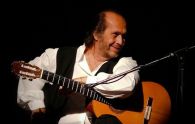Welcome to one of the most active flamenco sites on the Internet. Guests can read most posts but if you want to participate click here to register.
This site is dedicated to the memory of Paco de Lucía, Ron Mitchell, Guy Williams, Linda Elvira, Philip John Lee, Craig Eros, Ben Woods, David Serva and Tom Blackshear who went ahead of us.
We receive 12,200 visitors a month from 200 countries and 1.7 million page impressions a year. To advertise on this site please contact us.
|

|
|
Alegrias for dancers - help!
|
You are logged in as Guest
|
|
Users viewing this topic: none
|
|
Login  | |
|

   
Francisco
Posts: 879
Joined: Jun. 13 2005
From: SW USA

|
 RE: Alegrias for dancers - help! (in reply to Greg) RE: Alegrias for dancers - help! (in reply to Greg)
|
|
|
Here's a little nugget I came across over at flamenco-teacher. Behzad posted it, and does an awesome job. He states (as does Thomas) that this is not the only format, and the format can actually vary alot. Anyway, atleast it's a start.
quote:
Behzad
This is something interesting that I like to put my 2 cents in. I will explain to you the overall form of a danced Alegrias. But, I also encourage others to do so as well. The reason why I say this is because there is a general structure, but everyone (as in dancers) have something different. And I think that what I say is certainly not the "only" way, its just my personal perception, and I believe everyone else's is different too, and I find that very interesting. Anyways, here is how I think of it:
GENERAL FORM:
-Entrada
-Letra
-Silencio
-Escobilla
-Buleria de Cadiz
Now to get a bit more in depth:
1. Entrada (play some kind of opening falseta and "close it" with a musical llamada)
2. Llamada ("Call" - they can be usually one or two compas long)
3. Salida (singer sings "Tiriti tran tran tran")
4. Cierre(?) (I personally -in a good way- am a bit confused about cierre and llamada, but that's just the lingo I guess. For the rest of this, I will just call them llamadas until someone clarifies)
5. Letra (verse)
6. Coletilla/Estrebillo (I don't know which is the correct term, but it immediately follows the letra, and is technically a part of it. Its usually -but not always- the same lyrics from one letra to another)
7. Some possible footwork.
8. Optional repeat of #4-7, but with a different letra.
9. Build up
10. Llamada (or is it a displante? I get different opinions from everyone. Anyone, please clarify).
11. Silencio (There is a set number of compas in this. There is 6 compas if you are thinking in 12, or 12 if you are thinking in 6. Its got the mood of the solea. Its in the parallel minor of the key of the piece. So if you are playing in E major, then the silencio is usually in E minor. At the end of the piece it slowly modulates back to the major. A good starting one is the one on page 66 of Gerhard Graf-Martinez' book vol.1).
----------------#12 through 13 is optional, otherwise the dancer can go right into the escobilla from here.--------------------
12. Castellana (This is optional. It starts off with the dancer going “&2-3-4-5-6-7&a-8&a-9&a-10”, usually in that rhythmic scheme; the 7 through 10 usually in triplets, but they don’t have to be. Then the Castella estrebillo is sung usually twice. Harmonically, its usually similar to the Salida except that its with words).
13. Closing llamada.
14. Escobilla (The escobilla starts on beat 1!!! Whether you think of the rest of the piece as starting on beat 12 or 1, then escobilla starts on 1. This is important to know for the next part which will be explained next.
15. Build up after getting out of the escobilla (the way you “get out” of the escobilla is watch out for the dancer to switch his/her footwork to beat 12. That is when you stop playing the escobilla music and go into regular compas (more of a bulerias feel).
----------#16-17 is optional, otherwise you go to #18-------------
16. Llamada to close.
17. Optional solo de pie (it’s a palo seco, so just strumming the strings with no chords. Its usually got the feel of a solea por buleria, but sometimes its done in 3’s like a verdiales.
18. Llamada
19. Buleria de Cadiz (it’s a form of bulerias that is in major. The phrase is usually 4 compas long, but is done twice in a row).
--------------#20 is optional, otherwise go to #21-------------------
20. Ida (The dancer goes to one of the front corners of the stage, and dances the ida, usually the same thing as the salida – “tiriti tran”).
21. Build up.
22. Displante (or llamada, whatever you want to call it).
Like I said, this is just my interpretation. Its never done just this way. Its either more simple or more complicated. Sometimes in random parts someone might request something like “okay, do a falseta here”, whatever. And the above should just be one point of reference, otherwise you will come up with your own version.
What else is really important is that you have the music down. As in, you would need: basic compas, a falseta for the intro, salida chords letra with coletilla/estrebillo chords, silencio falseta, the escobilla music (aka “Caracoles falseta”), 1 compas llamada, 2 compas llamada, castellana chords (salida chords will do), Buleria de Cadiz chords.
|
|
|
|
REPORT THIS POST AS INAPPROPRIATE |
Date Mar. 17 2006 2:09:55
 |
|

   
Ricardo
Posts: 14861
Joined: Dec. 14 2004
From: Washington DC

|
 RE: Alegrias for dancers - help! (in reply to XXX) RE: Alegrias for dancers - help! (in reply to XXX)
|
|
|
quote:
Holy shoe! Do I have to learn it all to make accompainment?!
Unfortunately, even if you had all that structure memorized and actually understood what it all looked like applied to a peticular dance, it still would not mean you would do as good for another dancer. You see in addition to all that "structure", you have the DETAILS, all the little rhythmic nuances, cortes (little stops), off the beat accentuations, and to top it off, some dancers want to do something deliberately different than the norm that YOU have to memorize...and all without "thinking" about the compas. So in short, yeah you must know it, it is just the base blue print, to do good there is SO much more to it.
Fortunately, if you CAN do this for about 3 different dancers, then you start to get the idea of what is important, what is not so important, what are the typical rhythmic phrases, etc. You start to make educated guesses until you gain the confidence to accompany ANYONE, even with little or no rehearsal. And for me after I understood the structure of Alegrias, I had no problem with something like Solea, Solea Por Bulerias, Tientos, Siguiriyas, Guajiras, etc, similar structure idea. Alegrias has the the MOST different sections, so in terms of structure it has the most stuff to memorize.
Ricardo
PS, BECKO, yeah there are simplier versions, but in Behzad's post he gives the simple structure first, then goes into detail. The post was in regards to Baile, not cante or guitar solos.
|
|
|
|
REPORT THIS POST AS INAPPROPRIATE |
Date Mar. 17 2006 16:52:16
 |
|

   
Francisco
Posts: 879
Joined: Jun. 13 2005
From: SW USA

|
 RE: Alegrias for dancers - help! (in reply to Greg) RE: Alegrias for dancers - help! (in reply to Greg)
|
|
|
quote:
...after I understood the structure of Alegrias, I had no problem with something like Solea, Solea Por Bulerias, Tientos, Siguiriyas, Guajiras, etc, similar structure idea. Alegrias has the the MOST different sections, so in terms of structure it has the most stuff to memorize.
Thanks for that info, Ricardo. The more I learn, the more I realize I don't know. The compas are coming along nicely, but the theory is lagging behind. This, I believe, is partially due to a lack of understanding the overall structure. Behzad's post was the kind of help I needed to get things started. I've been spending alot of time at Buleria Chuck's website, I feel like ist is starting to pay off.
EDIT: i don't know how to spell lack
|
|
|
|
REPORT THIS POST AS INAPPROPRIATE |
Date Mar. 17 2006 23:54:57
 |
|
 New Messages New Messages |
 No New Messages No New Messages |
 Hot Topic w/ New Messages Hot Topic w/ New Messages |
 Hot Topic w/o New Messages Hot Topic w/o New Messages |
 Locked w/ New Messages Locked w/ New Messages |
 Locked w/o New Messages Locked w/o New Messages |
|
 Post New Thread
Post New Thread
 Reply to Message
Reply to Message
 Post New Poll
Post New Poll
 Submit Vote
Submit Vote
 Delete My Own Post
Delete My Own Post
 Delete My Own Thread
Delete My Own Thread
 Rate Posts
Rate Posts
|
|
|
Forum Software powered by ASP Playground Advanced Edition 2.0.5
Copyright © 2000 - 2003 ASPPlayground.NET |
0.078125 secs.
|


 Printable Version
Printable Version







 Even if you play solo guitar, you want to use a certain structure with an intro, a
Even if you play solo guitar, you want to use a certain structure with an intro, a 



 New Messages
New Messages No New Messages
No New Messages Hot Topic w/ New Messages
Hot Topic w/ New Messages Hot Topic w/o New Messages
Hot Topic w/o New Messages Locked w/ New Messages
Locked w/ New Messages Locked w/o New Messages
Locked w/o New Messages Post New Thread
Post New Thread